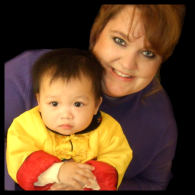This article was sent to me from a friend, Thanks Susan, and I found it very interesting. My job depends on my computer skills. I am at my computer 8 to 9 hours at work...then after G goes to bed. It's a lifeline to me. Some people smoke...some drink... mine is using the computer. It's not that I'm am just internet junkie...but also a graphic designer wannabe, photoshopper, excel queen and word user!!! I'm also a facebooker, an emailer, a yahoo grouper and a bloglines addict!!! It's made me a happier person and I could NEVER go back to that life...the one without all this! It will be interesting to see how our world changes as our toddlers grow up in this "age". I guess the best path is moderation...
Digital-age brains a new challenge for educators
By Mark Anderson
Lives lived in the digital age are going to be fundamentally different from lives lived at any other time, and the reason—or culprit—will be our brains, says Gary Johnson, a licensed psychologist and family therapist and director of Loring Family’s C.A.L.M. clinic in Minneapolis.
Johnson delivered one of the keynote addresses at November’s NAMTA conference, exploring the effects that an increasingly digital environment is having on brain development, and the benefits and threats those pose to children.
Researchers are obtaining ever more detailed images of brain activities, and they’re discovering marked changes in brain size and capabilities—the result of living increasingly in an electronic world.
“Genetic changes in brains used to occur over thousands of years,” Johnson says, but the pace of change has picked up at an astonishing rate since the dawn of the Internet. “Children’s brains are significantly different now than they were just three generations ago.”
That was the time when we started to live with pervasive electronic inputs, beginning with TVs and moving to cell phones, DVRs, the Internet, YouTube, Facebook and Twitter. Research conducted several years ago concluded that children were participating in electronic activities for eight-and-a-half hours each day.
Johnson says that number is certainly higher today.
Children and adults are separated now not just by their difference in age or fashion, but by a deep digital divide. On one side are the digital natives, young people weaned and nourished on a steady diet of electronic experience. Their incessant online activity has sharpened many valuable skills. They’re able to multitask, in the sense of moving rapidly and effectively from one task to another. Their peripheral vision is improved—thanks to those years of rapidly scanning screens—and their ability to sift large amounts of information also outpaces their elders.
On the other side are digital immigrants, the elders who may have picked up many electronic skills, but whose brains are shaped by old-fashioned physical and communal pastimes.
Immigrants are slower, but they probe deeper into subjects. One study showed that immigrants and natives matched performance on a series of tasks until they were confronted with an Internet search. The immigrants pursued topics at length, through numerous online links; the natives followed two links then moved on to the next topic.
Mapping also shows that when natives are engaged in online tasks the portion of their brain mass that’s active is much larger than in their older peers—their brains steadily devote more connections to the intriguing challenges they face and master, hour after hour.
But some of the consequences that researchers discovered as results of those radical changes are sobering and demand our response. A brain shaped by video games rather than interaction with other children, nature and caring adults displays predictable outcomes. Children now have less skill at face-to-face interactions than in the past. They can’t discern emotional tones. They can’t read subtle nonverbal communication, and they feel less empathy.
All that means that their ability to connect with others is weakened, Johnson says.
Those emerging deficits will leave a generation with little aptitude in the most important human activities unless elders and educators adapt, he says. “If you assume kids are learning like you did, you’re wrong. We’re going to have to teach social skills now in schools. Otherwise we’ll have a generation that can do well on tests, but they’ll have crappy relationships.”
The Montessori educators are in a position to lead the educational response because these children won’t respond to lectures and texts, they’ll respond to guides. And you’re already there.”
But the threat is formidable, and Johnson warned that children with special needs will often be especially vulnerable. For children who already feel their differences acutely and painfully, an additional measure of isolation means loneliness and resentment. And the haven that Johnson worries that youngster will fall into is the vivid, controllable world of online games, a frequently violent world filled with hazards alongside its wonders.
INFO: The website for Johnson’s Clinic for Attention, Learning and Memory is http://www.calm.us/.
Digital-age brains a new challenge for educators
By Mark Anderson
Lives lived in the digital age are going to be fundamentally different from lives lived at any other time, and the reason—or culprit—will be our brains, says Gary Johnson, a licensed psychologist and family therapist and director of Loring Family’s C.A.L.M. clinic in Minneapolis.
Johnson delivered one of the keynote addresses at November’s NAMTA conference, exploring the effects that an increasingly digital environment is having on brain development, and the benefits and threats those pose to children.
Researchers are obtaining ever more detailed images of brain activities, and they’re discovering marked changes in brain size and capabilities—the result of living increasingly in an electronic world.
“Genetic changes in brains used to occur over thousands of years,” Johnson says, but the pace of change has picked up at an astonishing rate since the dawn of the Internet. “Children’s brains are significantly different now than they were just three generations ago.”
That was the time when we started to live with pervasive electronic inputs, beginning with TVs and moving to cell phones, DVRs, the Internet, YouTube, Facebook and Twitter. Research conducted several years ago concluded that children were participating in electronic activities for eight-and-a-half hours each day.
Johnson says that number is certainly higher today.
Children and adults are separated now not just by their difference in age or fashion, but by a deep digital divide. On one side are the digital natives, young people weaned and nourished on a steady diet of electronic experience. Their incessant online activity has sharpened many valuable skills. They’re able to multitask, in the sense of moving rapidly and effectively from one task to another. Their peripheral vision is improved—thanks to those years of rapidly scanning screens—and their ability to sift large amounts of information also outpaces their elders.
On the other side are digital immigrants, the elders who may have picked up many electronic skills, but whose brains are shaped by old-fashioned physical and communal pastimes.
Immigrants are slower, but they probe deeper into subjects. One study showed that immigrants and natives matched performance on a series of tasks until they were confronted with an Internet search. The immigrants pursued topics at length, through numerous online links; the natives followed two links then moved on to the next topic.
Mapping also shows that when natives are engaged in online tasks the portion of their brain mass that’s active is much larger than in their older peers—their brains steadily devote more connections to the intriguing challenges they face and master, hour after hour.
But some of the consequences that researchers discovered as results of those radical changes are sobering and demand our response. A brain shaped by video games rather than interaction with other children, nature and caring adults displays predictable outcomes. Children now have less skill at face-to-face interactions than in the past. They can’t discern emotional tones. They can’t read subtle nonverbal communication, and they feel less empathy.
All that means that their ability to connect with others is weakened, Johnson says.
Those emerging deficits will leave a generation with little aptitude in the most important human activities unless elders and educators adapt, he says. “If you assume kids are learning like you did, you’re wrong. We’re going to have to teach social skills now in schools. Otherwise we’ll have a generation that can do well on tests, but they’ll have crappy relationships.”
The Montessori educators are in a position to lead the educational response because these children won’t respond to lectures and texts, they’ll respond to guides. And you’re already there.”
But the threat is formidable, and Johnson warned that children with special needs will often be especially vulnerable. For children who already feel their differences acutely and painfully, an additional measure of isolation means loneliness and resentment. And the haven that Johnson worries that youngster will fall into is the vivid, controllable world of online games, a frequently violent world filled with hazards alongside its wonders.
INFO: The website for Johnson’s Clinic for Attention, Learning and Memory is http://www.calm.us/.
This article was found here.






























































1 comment:
Hi Stephe I knew you would think this was intresting. I will send you more as I get them. :)
Post a Comment